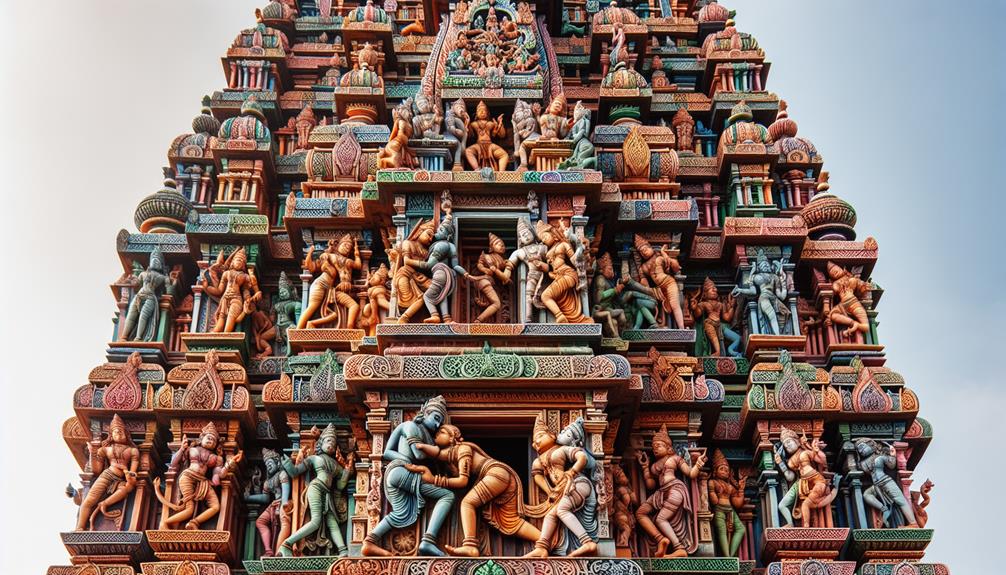What Religion Uses The Kama Sutra
The Kama Sutra is a text that has intrigued many, sparking curiosity about its religious connections. While often associated with a certain religion, the origins of this ancient Indian text raise questions about its ties to spiritual beliefs.
What Religion Uses The Kama Sutra
Understanding the role of Kama in Hinduism sheds light on the significance of this text in religious practices. Symbolism within the Kama Sutra hints at deeper spiritual meanings, leading to contemplation on its usage within religious contexts.
What Religion Uses The Kama Sutra
Exploring the practices outlined in the Kama Sutra and their religious implications offers a window into a world where sensuality intertwines with faith, enticing further exploration.
What Religion Uses The Kama Sutra
Key Takeaways
- Hinduism incorporates the Kama Sutra, valuing desire and pleasure within moral boundaries.
- The text symbolizes the integration of physical intimacy with emotional connections.
- The Kama Sutra explores the sacred connection between pleasure and spiritual enlightenment.
- It promotes balance, harmony, and mindfulness in relationships, emphasizing mutual respect and communication.
Origins of the Kama Sutra
The origins of the Kama Sutra can be traced back to ancient India, where it was believed to have been composed by the sage Vatsyayana. This ancient text, written in Sanskrit, is a guide to living a virtuous and fulfilling life, covering various aspects of relationships, love, and human behavior. Originally known as the Kamasutra, which translates to 'Aphorisms on Love,' the text is not merely a manual on sexual positions, as commonly misunderstood, but a comprehensive guide to a well-rounded life, including social conduct, personal relationships, and aesthetic appreciation.
What Religion Uses The Kama Sutra
Vatsyayana's work is a significant contribution to the cultural and philosophical heritage of India. The Kama Sutra delves into the intricacies of human relationships, emphasizing the importance of mutual respect, understanding, and communication. It provides insights into the art of seduction, the psychology of attraction, and the significance of physical intimacy within the context of a broader emotional connection. Through its teachings, the Kama Sutra aims to guide individuals towards a more enlightened and harmonious way of life.
What Religion Uses The Kama Sutra
Role of Kama in Hinduism
In Hinduism, the concept of Kama holds a significant role, intertwining with broader philosophical and spiritual teachings. Kama, which translates to desire or pleasure, is one of the four goals of human life, known as Purusharthas. Alongside Dharma (duty), Artha (wealth), and Moksha (liberation), Kama is seen as a legitimate and essential pursuit for individuals seeking a balanced and fulfilling life. In Hindu scriptures, such as the Vedas and the Upanishads, the importance of Kama is emphasized as part of the holistic approach to human existence.
What Religion Uses The Kama Sutra
Kama in Hinduism goes beyond mere physical pleasure; it encompasses emotional, mental, and spiritual dimensions. The pursuit of Kama is viewed as a natural and harmonious aspect of life, celebrating love, sensuality, and intimacy within the boundaries of dharma (moral duties). Through the practice of Kama, individuals can deepen their understanding of themselves, their relationships, and their connection to the divine. Ultimately, the role of Kama in Hinduism is to foster personal growth, emotional well-being, and spiritual evolution.
What Religion Uses The Kama Sutra
Symbolism in Kama Sutra
Exploring the intricate layers of symbolism within the Kama Sutra reveals a rich tapestry of cultural, spiritual, and philosophical meanings. The symbolism embedded in this ancient text goes beyond mere physical pleasure and encompasses deeper aspects of human connection, spirituality, and personal growth.
Here are three key symbolic elements within the Kama Sutra that resonate with individuals seeking a sense of belonging:
- Union of Body and Spirit: The Kama Sutra symbolizes the harmonious integration of physical intimacy with emotional connection, emphasizing the importance of holistic relationships.
- Cycle of Life and Renewal: Through its teachings on pleasure, procreation, and rejuvenation, the Kama Sutra symbolizes the cyclical nature of life and the continuous renewal of energy and vitality.
- Balance and Harmony: Central to the Kama Sutra's symbolism is the concept of balance in all aspects of life, promoting harmony between individuals, nature, and the divine.
Kama Sutra Practices in Religion
Interweaving ancient rituals and spiritual beliefs, Kama Sutra practices offer a unique perspective on the intersection of religion and intimacy. Within certain religious traditions, the Kama Sutra is not merely a guide to sexual positions but a spiritual text that explores the connection between physical pleasure and divine enlightenment.
In Hinduism, for example, the Kama Sutra is viewed as a sacred scripture that celebrates the art of love and the pursuit of pleasure within the context of dharma, or righteous living.
In Tantric Buddhism, the Kama Sutra is integrated into meditation practices as a means to channel energy and achieve spiritual awakening through physical intimacy. These traditions emphasize the importance of mutual respect, communication, and mindfulness in intimate relationships. By incorporating Kama Sutra teachings into their religious practices, followers seek to deepen their connection with both their partners and the divine.
Modern Interpretations and Controversies
Recent interpretations and controversies surrounding the Kama Sutra have sparked discussions on its relevance in modern society and its impact on perceptions of intimacy and relationships. In today's context, the Kama Sutra is viewed through various lenses, leading to debates and differing opinions on its significance. Some argue that it promotes healthy attitudes towards sexuality and fosters deeper connections between partners, while others criticize it for perpetuating outdated gender roles and unrealistic expectations.
The ongoing debate over whether the Kama Sutra empowers individuals to explore their desires freely or imposes societal norms on intimacy.
The impact of cultural appropriation on the interpretation of the Kama Sutra in a globalized world.
The role of the Kama Sutra in shaping modern views on consent, pleasure, and communication in relationships.
These discussions highlight the complexities of navigating tradition and modernity in matters of love and intimacy, emphasizing the need for open dialogue and critical reflection in our evolving society.
Frequently Asked Questions
How Has the Kama Sutra Influenced Popular Culture and Media Outside of Its Religious Context?
The Kama Sutra's influence on popular culture and media transcends its religious origins. Through its depiction of intimate relationships and sexual practices, the text has inspired various art forms, literature, films, and even fashion trends.
Its emphasis on love, passion, and sensuality has shaped modern perceptions of romance and sexuality. The Kama Sutra continues to be a prominent source of inspiration for creative expression and discussions on human relationships across different cultures.
Are There Any Specific Rituals or Ceremonies in Hinduism That Incorporate Teachings From the Kama Sutra?
In Hinduism, specific rituals or ceremonies that directly incorporate teachings from the Kama Sutra are not prevalent.
The Kama Sutra, an ancient Indian text on human sexual behavior and relationships, is primarily a guide on virtuous living and sensual pleasure.
While some aspects of the Kama Sutra may inform cultural practices, its direct integration into Hindu rituals is not a common phenomenon within mainstream Hinduism.
Can Individuals From Other Religions or Belief Systems Practice the Teachings of the Kama Sutra?
Individuals from various religious or belief systems can practice the teachings of the Kama Sutra, as its principles are not exclusive to a particular faith. The Kama Sutra is a guide on relationships, love, and intimacy, and its teachings can be beneficial to anyone seeking to enhance their romantic life.
How Has the Perception of the Kama Sutra Evolved Over Time, Both Within the Religion It Originated From and in Society at Large?
The perception of the Kama Sutra has evolved over time within the culture it originated from and in broader society. Initially seen as a comprehensive guide to a fulfilling life, it has faced periods of misinterpretation, censorship, and misconception.
Today, there is a growing recognition of its cultural and historical significance, with efforts to reclaim its original intention as a text promoting love, connection, and intimacy.
Are There Any Modern Adaptations or Reinterpretations of the Kama Sutra That Challenge Traditional Beliefs About Sexuality and Relationships?
In contemporary times, there are various modern adaptations and reinterpretations of the Kama Sutra that aim to challenge traditional beliefs about sexuality and relationships.
These adaptations often seek to promote inclusivity, diversity, and empowerment in the realm of intimacy.
Conclusion
In conclusion, the Kama Sutra originated in Hinduism, where it plays a significant role as a guide for relationships and sexuality. It is a symbolic text that explores the art of love and pleasure.
While some religious practices incorporate elements of the Kama Sutra, its modern interpretations have sparked controversies. The Kama Sutra continues to be a source of fascination and debate, reflecting the complexities of human desires and relationships.

